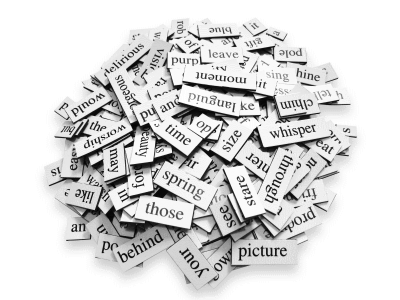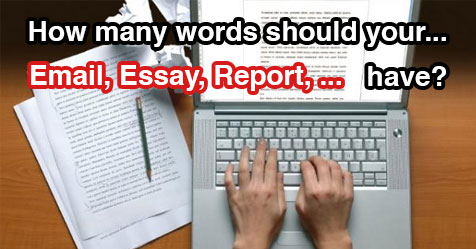Short words No. 1 predictor of readability
Pulitzer Prize-winning humorist Dave Barry spent eight years teaching businesspeople how to write better. As he told Time magazine:
“I’d lecture a bunch of chemists or engineers about the importance of not saying ‘It would be appreciated if you would contact the undersigned by telephone at your earliest possible convenience,’ and instead saying ‘Please call me as soon as you can.’ That was revealed wisdom to these people.”
Take a tip from Barry: Avoid multisyllabic exhibitions of verbosity. Use short words.
What’s wrong with long words?
Why avoid long words? Because they:
1. Slash readability.
Word length, along with sentence length, are the top two indicators of reading ease, writes readability expert William H. DuBay in Unlocking Language (PDF). For more than 80 years, researchers have proven in the lab — again and again — that short, simple words increase readability.
Here’s what the researchers found:
- Long words are harder to read. In 1928, Mabel Vogel and Carleton Washburne of Winnetka, Illinois, published 19 writing attributes that make messages harder to read. Of their 19 writing attributes that make messages harder to read, the top three centered on word familiarity.
- Vocabulary top predictor of difficulty. “Vocabulary load is the most important [accompaniment to] difficulty,” found Irving Lorge, a psychologist at Columbia University Teachers College, in 1944.
- Short, simple words boost readability. Shortening and simplifying words reduced the reading grade level from 11th to 5th in a 1981 study by researchers Thomas Duffy and Paula Kabance.
2. Reduce comprehension.
The shorter the words, the easier your copy is to read. Indeed, virtually every readability index uses word length as one measure of reading ease — or difficulty.
- Familiar words are easier to understand. Comprehension increases with word familiarity and ease, found readability researcher Ralph Ojemann in 1934. Word difficulty was among the top four factors he found that reduce understanding.
- Hard words reduce comprehension. The more difficult words a passage included, the harder it is to understand, found Ralph Tyler and Edgar Dale in 1934. The top two predictors of comprehension, they discovered, are the amount of jargon and the number of long or unfamiliar words.
- Common words boost understanding. Using only the percentage of common words and average number of words per sentence, Dale and Chall in 1948 published a readability formula that predicts comprehension with a 92% accuracy rate.
- One-syllable words increase comprehension. Shorter words increase understanding, found Edmund B. Coleman in his 1965 study measuring the percentage of one-syllable words.
- Word familiarity increases understanding. Word characteristics including functionality, familiarity and length affect comprehension, found readability expert G. R. Klare in a 1976 review of 36 readability studies.
As Skip Boyer, the late executive producer and director of executive communication at Best Western International Inc. wrote: “Readers may know that utilize means use and optimum means best. But why make them translate?”
3. Suck the color from your piece.
Small words are compelling, as well as clear, because they’re often concrete. That is, they describe things rather than ideas. That helps our readers visualize your information so they understand it faster and remember it longer.
Let’s test that: Which do you see? A visual-duration-sensing apparatus? Or a clock?
4. Sound stuffy and bureaucratic.
When a speechwriter for President Franklin D. Roosevelt wrote, “We are endeavoring to construct a more inclusive society,” FDR changed it to, “We’re going to make a country in which no one is left out.”
No wonder. Simpler words are more accessible — and less self-important.
Corporate communicator Chris Winters calls using stuffy, bureaucratic words the “Look, ma! I’m writing!” syndrome.
5. Don’t get shared.
The average length of a word in a tweet that gets retweeted is 1.62 syllables, according to a study by viral marketing scientist Dan Zarrella. Want to get the word out on Twitter? Use mostly one- and two-syllable words.
6. Make you sound pompous and dense.
Using stuffy words might make you sound stuffy. But it won’t make you sound smarter. In fact, people who use big words when smaller ones will do actually sound less intelligent, according to research at Stanford University.
7. Make you seem dishonest.
“The great enemy of clear language is insincerity,” wrote English novelist George Orwell in ‘Politics and the English Language.’ “When there is a gap between one’s real and one’s declared aims, one turns … instinctively to long words and exhausted idioms, like a cuttlefish squirting out ink.”
Orwell also wrote: “Words like phenomenon, element, individual (as noun), objective, categorical, effective, virtual, basic, primary, promote, constitute, exhibit, exploit, utilize, eliminate, liquidate, are used to dress up simple statements and give an air of scientific impartiality to biased judgments.”
Still writing “single-operation computer architecture unit of data bus”? Stop it.
Small wonder
“Sure,” you say, “Ann Wylie can write using mostly one- and two-syllable words. She has little ideas. But my big ideas can only be expressed in big words.”
But one of the biggest ideas in the history of our country was expressed in the Gettysburg Address. Of the 235 words Lincoln used in the Gettysburg Address (that’s fewer than the number on the back of a potato chip package today), 174 of them have only one syllable.
So we can express big ideas with small words. In fact, short words express ideas faster and to more people than long words.
And isn’t that what the best writers aim to do?
-
How long should your message be?
Would your message be twice as good if it were half as long?
Yes, the research says. The shorter your message, the more likely readers are to read it, understand it and make good decisions based on it.
So how long is too long? What’s the right length for your piece? Your paragraphs? Your sentences? Your words?
Find out at Rev Up Readability — our clear-writing workshop, starting May 26.
There, you’ll use a cool (free!) tool to analyze your message for 33 readability metrics. You’ll leave with quantifiable targets, tips and techniques for measurably boosting readability.
Save up to $100 with our group discounts.
Browse all upcoming master classes.
Think word count isn’t important in writing? Well, think again. As a writer, the number of words in a piece matters a great deal; it is the only measure of productivity you have. Therefore, you need to ensure the number is within what’s expected for your genre and category. So how many words should your text have? Let’s take a comprehensive look at our word count list, and find out how it all works.
A good average sentence length
There’s no perfect length, however, a well-written sentence should have 15-20 words on average. Using simple and short sentences will help more people to understand your content. But restrain from using uniform sentence lengths if you don’t want your writings to be choppy and without flow.
Though there’s the possibility of long structured sentences being balanced and readable, comprehension often drops and readers may struggle to understand the whole content. People expect you to get to the point, especially your busiest readers. They don’t have the time to slow down to deconstruct the long, complicated sentences and contemplate the clauses. By making it simple, it shows you respect your content reader’s time and interest.
How many words in a paragraph?
As you can expect, there is no fixed number of words that a paragraph should have. A rule of thumb: the paragraphs are usually about 100 to 200 words long, which is about 6-8 sentences. Nevertheless, it all depends on the ideas, and ideas come in many sizes. So the paragraph can be long enough to reach its end. But we can’t ignore the fact that readers don’t like seeing blocks of paragraphs. And it’s for that reason you should stick to one concept or idea per paragraph to avoid creating very long paragraphs. Simply shift to a new paragraph when you shift to a new concept/idea.
How many words in an essay?
A standard essay must be a minimum of 3-5 paragraphs, but if you’re not instructed to write the given paragraphs, there’s no point sticking to this extremely limiting rule. This is handy in academic writing, where your paragraphs are expected to be longer than most essays. On average, there are 100 to 200 words in a paragraph. And as a general rule with essays, you’ll have an introduction, body, and conclusion. So you can assume that a 1500-word essay will likely to have about 5-8 paragraphs. Remember your essay will be evaluated on the content you present, not the number of paragraphs.
How long should a book be?
Though the length of your book is determined by the details needed to make it good, it is important to adhere to the expected word count in your genre and category. It demonstrates how well you understand your market. And in line with this, here are the industry norms worth knowing.
- Under 500 words is generally considered flash fiction
- A short story: 1,000-8,000 words
- Novella Story: 10,000-40,000 words
Novel
A 40,000-word manuscript can be considered to be a novel, but to be eligible for finisher status, you’re required to write a minimum of 50,000 words. The maximum word is generally 60,000-100,000 words.
Sci-Fi and Fantasy Books
There is no rule on the word limit regarding science and fantasy fiction books. However, most of the books usually fall within the 90,000-120,000 words. The publisher and agents are more lenient on word limits for this genre; therefore, you’re not likely to lose out on a deal if you exceeded the number of words. You may be wondering why the books in this category are an exception. Well, reading epic novels of this genre are interesting and require the audience to take some time to create the fantasy world around them, and then imagine themselves in it.
Adult Novels
The generally recommended words usually fall between 80,000 and 100,000. If your manuscript is over 100,000 words, publishing it could prove to be more expensive.
Children Novels
The word length for children novels is not set in stone, but even so, its likely to be around 20,000 to 40,000 words.
What is the average word count for an email?
According to a study conducted by Email Labs, people spend about 15-20 seconds reading an email. Sending the readers lengthy email messages may make them feel overwhelmed, and might not read through it. Now, you may be tempted to ask, “what’s the right number of words for an email? “ Well, it all depends on the ideas or information you want to deliver. A rule of thumb: the shorter message, the better. Always try to limit your email to around 300 words or less. If your email message needs to be longer, it’s absolutely okay. However, focus on the main message, eliminate the distractions, and keep the content easy to scan.
There’s no set minimum or maximum, regardless of the type of report. If you’d like a guesstimate, just assume the audience will take around 10-20 minutes reading the report. And on average, your readers can read 1 double-spaced page or 250 words in a minute. In 10 minutes they would have read about 2,500-4,500 words. But that’s just an approximation.
Remember a few people read an entire report, so keep it simple and not too long.
How many words should your application have?
Whether you are applying for a job or college, it’s extremely important to keep in mind that there’ll be a long list of applicants. When you present a very long resume, you’re simply scaring off the person who’ll be reading it. Don’t forget he/she has other applications to review. Even if you were to be more qualified, there’s a great possibility of wasting your chances. So if you are not instructed to write within a certain word limit, just make sure your application is short as possible, typically less than 500 words.
How long should your motivational letters be?
While there are no exceptions, your letter of motivation shouldn’t be longer than one page. Make it around 300-500 words. It is crucial to keep it shorter, but make sure you highlight your most relevant qualifications and what you have to offer.
If you want to check your word and character count, improve writing style and word choice online, bookmark our online editor.

Writing guides generally agree that short words are preferable. Many take their cue from traditional authorities such as the Fowler brothers, who on page one of their influential The King’s English (1906) told readers: ‘Prefer the short word to the long.’
The preference dates back centuries. During the shift to modern English, our vocabulary swelled tremendously through borrowings from Latin, Greek, French and other languages. This sparked a vogue for inkhorn terms – so named because they required a lot of dipping in the inkhorn or inkpot. There then followed a counter-fashion for opposing these words and preserving the supposed plain purity of the Anglo-Saxon lexicon.
Many such anglicised imports failed to catch on (accersite, illecebrous, obtestate), but others were embraced and remain with us today (commemorate, dexterity, susceptible).
Don’t try to mystify
Though inkhorn terms can be wonderfully expressive, writers often used them to impress or mystify their readers. This tendency still exists: writers are occasionally suspicious of ordinary, familiar terms and replace them with ornate alternatives – sometimes in Latin. But using unnecessarily fancy phrasing is a reliable way to alienate readers. It makes prose puffed-up and heavy, so that reading it becomes a chore instead of a pleasure.
That said, long and obscure words don’t deserve to be blacklisted outright. Sesquipedalianism (or sesquipedality: literally, the use of words 1.5 feet long) is not intrinsically wrong, but make sure you indulge in it with restraint and an awareness of readers’ needs and expectations. Otherwise it can overshadow the ideas you’re trying to communicate.
When deciding on a word, ask yourself: is its meaning clear and precise? Is it consistent with the style of language around it? Maybe it’s too formal; maybe it’s not formal enough. Does it stand out? If so, does it do so acceptably, awkwardly, or just pretentiously? Even casual readers notice when a writer is trying too hard.
Finding the right word
Instead of the short word, we’re sometimes told to choose the right word. But the right word isn’t always obvious, and there are degrees of rightness. As the Austrian writer Karl Kraus said, ‘The closer the look one takes at a word, the greater the distance from which it looks back.’ Language tends to approximate our thoughts rather than match them exactly, so choosing the best word can be a deft and delicate business.
The connection between a word and its referent is slippery and complex. Many concepts connect to a constellation of terms, each with its own history, idiosyncrasies and connotations. Be careful of words you’re not very familiar with – it’s a bad idea to grab a thesaurus and adopt a near-synonym just because it sounds a bit fancier or less predictable. That way lie potential confusion and absurdity.
Context is key. An unknown or half-known word might make enough sense in the context for readers to get the gist and continue. They can always double-check the meaning later, and they might even enjoy looking it up. But as a technique this requires skill and subtlety from the writer, and the more you do it the more likely you are to test readers’ patience. Don’t let the language interfere with the message.
Put yourself in the audience
Reading a line aloud to yourself is a good way to assess it. You don’t have to be theatrical; just whispering or mumbling it can help you get a sense of its rhythm and balance. Reading it quickly and silently in your head does little but reinforce what you think you said, which isn’t necessarily what readers hear. Asking a colleague is also worthwhile: their independent perspective is invaluable, since they will hear your prose in ways you can’t.
It’s easy to be too casual or overbearing with words, and this can devalue communication. ‘Everything should be made as simple as possible,’ Albert Einstein said, ‘but not simpler.’ Length of words is a factor, but by no means is it the primary one. More important is that we use the most appropriate and effective words, whatever their length, and that we do so in good faith. Remember to put readers first.
Long words may be beautiful, evocative and forceful; in the right place at the right time they can delight our ears, tickle our brains and stir our hearts. They can also annoy and exhaust us. A rich vocabulary can nag readers with its own grandiosity, masking an inability or unwillingness to engage in straightforward expression. Or it can be worn lightly and used with finesse and sensitivity. You, as writer, get to choose.
Image credit: Zoltan Gabor / Shutterstock


Добавил:
Upload
Опубликованный материал нарушает ваши авторские права? Сообщите нам.
Вуз:
Предмет:
Файл:
Скачиваний:
14
Добавлен:
06.02.2016
Размер:
26.11 Кб
Скачать
ПОСОБИЕ
ПО АНГЛИЙСКОМУ ЯЗЫКУ ДЛЯ СТУДЕНТОВ
ГУМАНИТАРНЫХ ВУЗОВ
13
-
You will probably modify it
as you gather information, but an outline will help to keep your
thinking in order.
-
Word length is a good gauge
of readability.
-
Most
readers of the Wall Street Journal, for example, are college
graduates, so the writing is more complex than that found in a
small-town daily.
-
Find
in the text the sentences where the Gerund is used. Translate
them and explain the usage of the Gerund. -
Insert prepositions:
-
Lincoln’s
Gettysburg Address consisted 267 words. -
The
words the left are better than the words the right. -
(…) the
standard word choice is different. -
Scientific
writing, too, is loaded esoteric words. -
Make an
outline what you are going to include your message.
7. Give
synonyms:
outline, concern, assignment,
short, to modify, readily, key (adj.)
8. Give
antonyms:
believable, brief, to
improve, complicated, desired, in order, necessary.
9. Answer
the questions:
-
What should a public
relations writer think over before beginning any writing
assignment? -
What should an outline
include? -
What is the structure of the
outline? -
What can improve the rhythm
of the material? -
What is the usual length of
the typical paragraph? -
How many words did Lincoln’s
Gettysburg Address consist of? -
What do writers often
forget? -
Which words are more
understandable: Anglo-Saxon or derived?
9) When
can more complex words be used?
10) Who seems to like elaborate
expressions?
10. Paraphrase
the italicized parts of the sentences
-
Before
beginning any writing assignment, take
the time to
ask yourself some key questions. -
In the
simplest terms, an
outline is a list of topics to be written about in the order in
which they will be presented. -
Writers
who are college-educated often forget that words common
to their vocabulary are
not readily understood by large
segments of
the general
public.
11. From
the list of words given in the section WORD CHOICE take 8 or
10
words from the left column and make up a situation with them.
Then
replace them with the ones from the right column. How
has the situation changed? Which variant do you prefer?
Why?
Соседние файлы в папке 1_22
- #
- #
- #
- #
- #
- #
- #
- #
- #
- #
- #
Is there are word count system that can be leveraged to gain high ranking on search engines? Does SEO take into account the length of an article? Is there a connection between word count and SEO at all or is it a myth? Let’s find out.
Content marketers and writers do have to confront this puzzle quite often – What is the ideal length of an article in terms of words and paragraphs?
Long Copy = Deep Research? Not Quite!
Yes, the length is an important factor and often puts other aspects into the background such as the core purpose of the copy, the intent of the content, and the audience it needs to address. For some reason, nearly every conversation with a client begins with word count and page length. Is it because of the popular belief that longer articles rank better? Do search engines believe that pages and pages of content indicate exhaustive and deep research entailing long hours of hard work that deserves a high ranking?
You have to agree that there is a strong belief among many people that a longer copy makes the content more rank-worthy. What can this misconception be attributed to?
Content marketing experts point out the presence of numerous studies around the word count subject but none of them provide any firm closure to the debate in the real sense. There are a lot of loose ends which means the confusion persists.
Relevance Matters More Than The Length
Many factors come into play while determining the right length of the content but the ranking of a page is not driven by its length alone. The objective of a page and its contents should be to provide the necessary information required by the visitor to achieve their objective of visiting that specific page.
In some cases, all they might need is a quick, crisp answer to a particular query and in other cases, they might require a detailed and in-depth explanation about a particular topic or subject. Going by this reasoning, the length of a content page does not hold as much importance as the quality and relevance of the information provided.
Google has made it implicitly clear that the needs of the user must take topmost priority and must be adequately addressed before anything else.
The focus should be on assisting the human visitor and not on supporting a search bot.
Is There a Proven Word Count for Best SEO?
If you believe that there is some formula by which search engine ranks an article based on its length then let it be clear that there is none. There are no Google guidelines that a specific number of words must be used for an article or page to rank high. The search engine algorithm is simply designed to rank pages based on its ability to satisfy the query of a user. There is no such rule that a content page with 2000 plus words will rank on the top search pages of Google, guaranteed! No.
Word count or volume is rarely a deciding factor according to many experts.
[bctt tweet=”The number of words of a copy is, without a doubt, the wrong way to measure its utility to the readers.” username=”relevance”]
This has been confirmed by none other than John Mueller, Senior Webmaster Trends Analyst at Google in one of his tweets some time back.
“Word count is not indicative of quality. Some pages have lots of words but say nothing. Some pages have very few words that are very important and relevant to queries. You know your content best (hopefully) and can decide whether it needs the details.”
There is also this trend of piling on words on a content page simply because your top-ranking competitor did it. Some marketers fear that they will be seen as providing lesser information if they do not match the same word count and page length as that of their competitors.
This again is not true! John tweets to set the record straight:
“Having the same word count as a top ranking article is not going to make your pages rank first, just like having a bunch of USB chargers isn’t going to get you to the moon. But, I’m still tempted to buy some of those USB chargers.”
Correlation Between Word Count and Ranking – Is There Any?
However, despite reassurances coming from the right places, a lot of people still believe that there is a correlation between word count and ranking. For instance, it the content length of the top pages for a specific search term is around 2,000 and more, they would see it as a definite sign that any page that has less than 2,000 words will not be considered for top ranking.
While this is understandable, it is definitely not the truth. The longer pages might be ranking well but the length of the content has nothing to do with the rank.
It is the quality of the content and its relevance on these that’s making these pages soar high on the search engine rankings.
It is also possible that it is the link profile of these pages that are driving its rankings.
What Determines the Length of a Copy
Logically speaking, the length of content should be directly proportional to the subject matter and the query it aims to address. Shorter content will do better than longer ones in places where there is no need to stretch the pages. For instance:
For content that seeks to address the query such as the metro station near me will be significantly less than that which addresses the question about the history of Wimbledon.
“Content should be factually accurate, clearly written, and comprehensive.” – Google’s SEO starter guide accurately captures the picture.
To make it more clear, comprehensive here means complete. The content should include everything necessary to address its core purpose. At the same time, it should be free of fluff and inane sentences and descriptions which hardly adds any value to the overall content.
Marketers have come up with a really practical explanation of why content must not be built around a fixed word count. A piece with a suggested word count runs the risk of becoming diluted and straying away from its stated objective. It may be assumed in such cases that the writer will try to fill the paragraphs and pages with a random volume of words with the sole purpose of reaching the word count, thus sacrificing the quality and crispiness of the content in the process.
Will that make a good reading material? Obviously no!
Will it provide the requisite information in the right manner? No again!
The Consequences of Fluffing:
- It affects the manner in which the copy will rank for the targeted keywords
- The keyword theming of the page will go astray with unwanted content making its way into the pages
- A page that was supposed to be crisp and relevant to the topic will lose its punch as other concepts are introduced to add to the length
- The ability of the page to rank for the targeted keywords may get severely affected
[bctt tweet=”Word count should never be the target. Delivering the message home is what writers and marketers should aim for.” username=”relevance”]
Purpose Over Word Count
Ask yourself what is the real purpose of the page you intend to create. Is it intended to provide information? Is it created to encourage visitors to explore other pages on the site? Is it for performing some transactions? The purpose of the content page will decide the length of the content.
When you provide visitors reliable and accurate information based on the purpose for which they visit the page, you can achieve the objective of ranking higher than your competitors in organic search results.
User Intent
User intent is another factor that will decide the length of the content of the page. What is the user looking for while landing on a specific page? If you know the answer to this and create content (regardless of the length) to satisfy their needs, your page will be a winner by all counts. The visitor is a busy individual who is unlikely to have the time and the patience to browse through a length description when a relatively crispier one would more than suffice.
A note of caution here: Making a page long does not help the visitor who comes for a purpose. It is more important to serve that purpose and achieve better rankings. And when you do that remember one more thing. Search engine optimization is of course about ranking high but it is more about converting traffic. Remember that while writing the copy.
Copy Length and Conversion
Is there a connection between copy length affects conversion?
While it’s a proven fact that reams of text might be off-putting for readers in some context such as a product description page, other types of pages might necessitate long copies to help visitors achieve their objective and complete an action.
The clear verdict, therefore, is that there is no right word count or best word count for SEO.
[bctt tweet=”Word count can never dictate a copy length, its objective should.” username=”relevance”]
The copy length should be such that it meets the needs of the user and also encourages conversion at the same time.
Some Interesting Research-Based Data
Here are some interesting observations based on extensive research of what the ideal length should be for various posts. Be warned that these are ideal representations based on the research of a large number of such posts and should not be viewed as the best practices. You can use these suggestions as a testing point for your posts wherever it is possible for you to use them.
Source
Tweets:
Tweets with less than 100 characters have a higher engagement rate
Facebook:
Facebook posts of around 40 characters get a higher rate of engagement. Posts with more character count generally grab lesser eyeballs.
Paragraphs:
Opening paragraphs with around 40-55 words resonate better with readers.
URL Domains:
Short and easy-to-remember domain names work best. Limit it to 8 characters for easy recall.
Hashtags:
6 characters define the perfect hashtag according to research. Avoid using special characters, don’t start with digits and no slangs, please.
Subject Lines:
Subject lines get the best click rates if they contain around 39 characters.
Title Tags:
Limit your title tags to less than 60 characters; 55 is the ideal number.
Blog Headlines:
Are you surprised to learn that the first 3 and the last 3 words of a headline are usually read? Don’t worry about the length but 6 words headlines work best for blogs.
LinkedIn Posts:
Limit the posts to 16-25 words for business marketing and 21-25 words for consumer marketing. At least, that’s what the trend says.
Blog Posts:
Blog posts that can be read under 6 minutes have a better engagement rate than those that can be read under 3 minutes. The ideal word count? 1600!
YouTube:
After researching the top 50 YouTube videos, it was revealed that the short ones are more popular with the average length being under 3 minutes.
Podcasts:
Attention can be retained for around 20 minutes only and that’s why the average podcast length should be around 20-22 minutes.
SlideShare:
6 minutes is the best time length for SlideShare.
It is important to understand that the post lengths and word counts mentioned for various sites are based on research by diverse agencies and sources. What works for others may not deliver the exact same results for you. This is undoubtedly some valuable data and can be used as a reference point for your needs.
To wind up, here is one from John Mueller again:
“Some low quality pages are unsatisfying because they have a small amount of main content for the purpose of the page. For example, imagine an encyclopedia article with just a few paragraphs on a very broad topic such as World War II. Important: An unsatisfying amount of main content is a sufficient reason to give a page a low quality rating.”


 So how long is too long? What’s the right length for your piece? Your paragraphs? Your sentences? Your words?
So how long is too long? What’s the right length for your piece? Your paragraphs? Your sentences? Your words?




